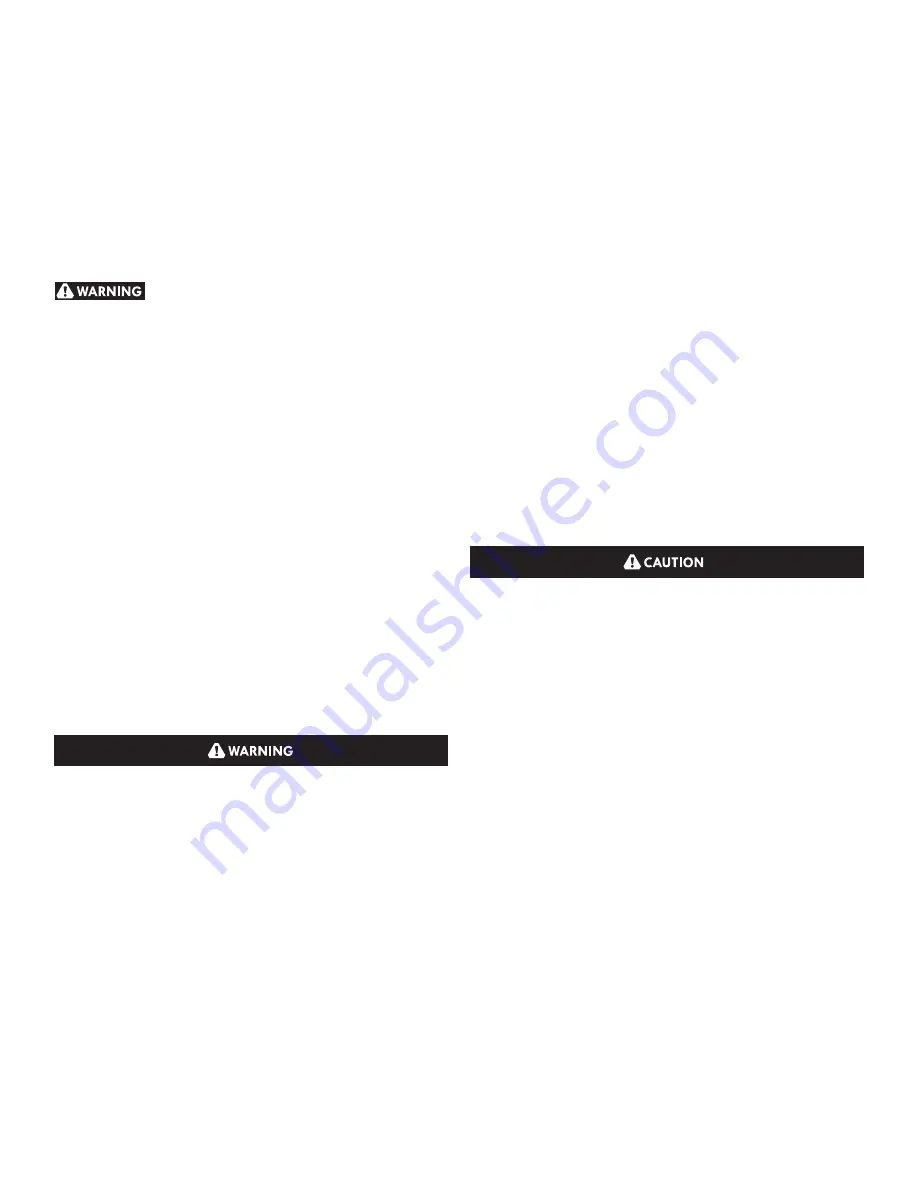
4
elements may be hot even though they are dark
in color. Areas near surface
zones may become
hot enough to cause burns. During and after use,
do not touch, or let clothing or other flammable
materials touch these areas until they have had
sufficient time to cool. Among these surfaces near
these openings, oven doors and windows).
• Wear Proper Apparel. Loose-fitting or hanging
garments should never be worn while using the
appliance.
Do not let clothing or other flammable
materials contact hot surfaces.
Never use your appliance for
warming or heating the room.
• Do Not Use Water or Flour on Grease Fires.
Smother the fire with a pan lid, or use baking
soda, a dry chemical or foam-type extinguisher.
• When heating fat or grease, watch it closely.
Fat or grease may catch fire if allowed to
become too hot.
•
Use Only Dry Potholders. Moist or damp
potholders on hot surfaces may result in burns
from steam.
Do not let the potholders touch hot
heating surface units. Do not use a towel or other
bulky cloth instead of a potholder.
•
Do Not Heat Unopened Food Containers.
Buildup of pressure may cause the container to
burst and result in injury.
IMPORTANT
—
Do not attempt to operate the
appliance during a power failure.
If power fails,
always turn off the appliance. If the appliance is
not turned off and the power resumes, it will begin
to operate again. Once the power resumes, reset
the clock and oven function.
IMPORTANT INSTRUCTIONS FOR USING
YOUR MICROWAVE
When using electrical appliances, basic safety
precautions should be followed to reduce the risk
of burns, electric shock, fire, injury to persons or
exposure to excessive microwave energy:
• REad all instructions before using the appliance.
• Read and follow the specific
“PRECAUTIONS
TO AVOID POSSIBLE EXPOSURE TO EXCESSIVE
MICROWAVE ENERGY”
.
• Install or locate this appliance only in accordance
with the provided installation instructions.
• Some products such as whole eggs and sealed
containers —for example, closed glass jars—are
able to explode and should not be heated in this
microwave oven.
• Use this appliance ONlY for its intended use as
described in this manual. Do not use corrosive
chemicals or vapors in this appliance. This type of
oven is specifically designed to heat, cook or dry
food. It is not designed for industrial or laboratory use.
• As with any appliance, ClOSE SUPERvISION is
IMPORTANT SAFETY INSTRUCTIONS
necessary when used by CHIlDREN or INFIRM
PERSON.
• This appliance, including power cord, must be
serviced ONlY by qualified service personnel.
Contact nearest Authorized Servicer for
examination, repair or adjustment.
• DO NOT cover or block any openings on the
appliance.
• DO NOT store or use this appliance outdoors.
• DO NOT use this product near water—for
example, near a kitchen sink, in a wet basement
or near a swimming pool, or similar locations.
• Oversized foods or oversized metal utensils should
NOT be inserted in a microwave oven as they
may create a fire or risk of electric shock.
• DO NOT clean with metal scouring pads. Pieces
can burn off the pad and touch electrical parts
involving a risk of electric shock.
• DO NOT use paper products when appliance is
operated in the convection or mix mode.
• DO NOT cover racks or any other part of the
microwave oven with metal foil. This will cause
overheating of the oven.
• Review the door cleaning instructions
To reduce the risk of fire in the microwave oven cavity:
•
Do not overcook food. Carefully attend appliance
when paper, plastic or other combustible
materials are placed inside the microwave oven
to facilitate cooking.
•
Remove wire twist-ties from paper or plastic bags
before placing bag in microwave oven.
•
If materials inside the microwave oven should
ignite, keep microwave oven door closed, turn
microwave oven off and disconnect the power
cord or shut off power at the fuse or circuit
breaker panel.
•
DO NOT use the cavity for storage purposes.
Do not leave paper products, cooking utensils or
food in the cavity when not in use.
Liquids, such as water, coffee or tea are able to
be overheated beyond the boiling point without
appearing to be boiling. visible bubbling or boiling
when the container is removed from the microwave
oven is not always present.
THIS COULD RESULT
IN VERY HOT LIQUIDS SUDDENLY BOILING
OVER WHEN A SPOON OR OTHER UTENSIL IS
INSERTED INTO THE LIQUID.
To reduce the risk of injury to persons:
•
DO NOT overheat the liquid.
•
Stir the liquid both before and halfway through
heating it.
•
Do not use straight-sided containers with narrow
necks. Use a wide-mouthed container.
•
After heating, allow the container to stand in the





































